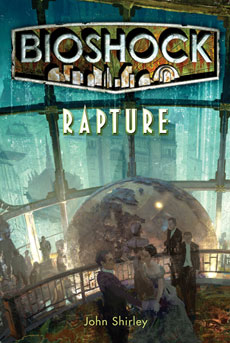 Tasked with lifting a story saddled with Ayn Rand philosophy above the levels of mediocrity that many videogame tie-in novels can only hope to achieve, it’s hard to believe that John Shirley had a chance.
Tasked with lifting a story saddled with Ayn Rand philosophy above the levels of mediocrity that many videogame tie-in novels can only hope to achieve, it’s hard to believe that John Shirley had a chance.
The tale of Rapture’s inception, construction and fall contains some interesting moments, but the best of them have already been heard in the game’s audio diaries, only stretched beyond the breaking point to fill a chapter rather than a 30-second audio clip. By the end almost every event has been taken from them, even going so far as to paste the dialogue from them in verbatim, leaving few surprises for anyone who was paying attention when they played through the original.
Characters who worked as enigmatic cameos feel like parodies when they and their philosophies are expanded like this; a feeling only enhanced by the author’s bizarre insistence on rendering every verbal tic and dialect on the page. Bill McDonagh, for example, is a working class bloke from Lahndahn, and then you’ve got the guido stereotypes for New York gangsters and, just in case you forget that the book is set in the 1940s, it’s loaded with deliberate archaisms so that people actually use words like ‘swell’.
Even if Andrew Ryan was less a nuanced personality and more a… well, an Ayn Rand character in the game, here he’s a pantomime villain. He takes every single opportunity to start monologuing about parasites, taxes and the Great Chain™. Within the first chapter he compares, completely without irony, Hiroshima and Nagasaki to socialism, and it’s downhill from there.
Fontaine, too, if he has a moustache would spend every scene twirling it. His character is built from the big book of villainous cliches, with an uncanny gift for disguise thanks to being brought up in the circus. No, really…
One thing the book does share with the games is that the true star is Rapture itself, and for those who gorged themselves on the details in things like the BioShock 2 ARG, the material here will delight. It still doesn’t make much sense if you think too hard about it, but moments like seeing the undersea city for the first time are nearly as potent as they were when you saw it for yourself. The game’s opening is still one of the best ever, and the book enjoys some of the reflected glory.
It’s not enough, though. The narrative and visuals in the games were strong enough to make you forgive some occasionally clunky mechanics, but this is just a bad reprise weighed down by dialogue and character development from a bad fan fiction. Fans will find a lot more canonical depth by spending a few hours exploring the BioShock Wiki.
